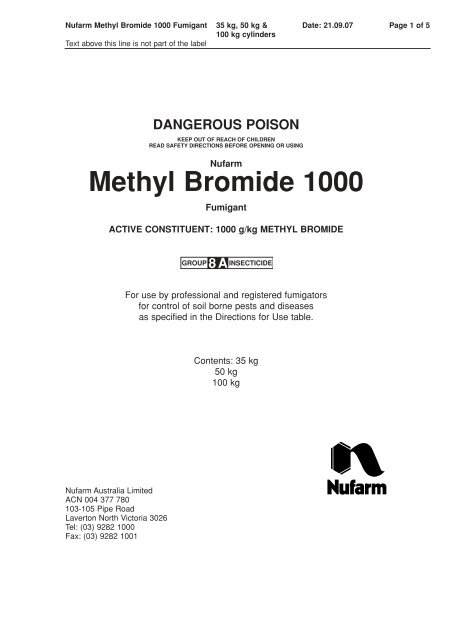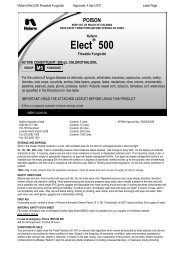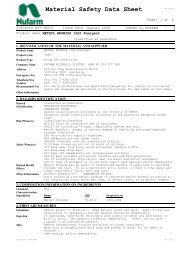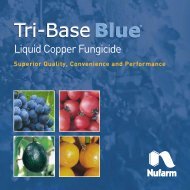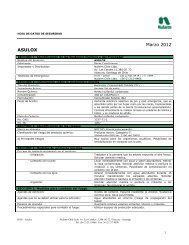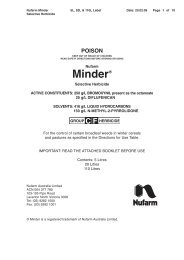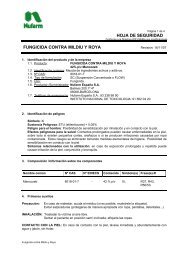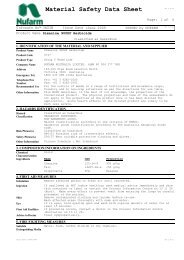17983 Methyl Bromide 1000 Master - Nufarm
17983 Methyl Bromide 1000 Master - Nufarm
17983 Methyl Bromide 1000 Master - Nufarm
You also want an ePaper? Increase the reach of your titles
YUMPU automatically turns print PDFs into web optimized ePapers that Google loves.
<strong>Nufarm</strong> <strong>Methyl</strong> <strong>Bromide</strong> <strong>1000</strong> Fumigant 35 kg, 50 kg & Date: 21.09.07 Page 1 of 5<br />
100 kg cylinders<br />
Text above this line is not part of the label<br />
DANGEROUS POISON<br />
KEEP OUT OF REACH OF CHILDREN<br />
READ SAFETY DIRECTIONS BEFORE OPENING OR USING<br />
<strong>Nufarm</strong><br />
<strong>Methyl</strong> <strong>Bromide</strong> <strong>1000</strong><br />
Fumigant<br />
ACTIVE CONSTITUENT: <strong>1000</strong> g/kg METHYL BROMIDE<br />
GROUP<br />
8A<br />
INSECTICIDE<br />
For use by professional and registered fumigators<br />
for control of soil borne pests and diseases<br />
as specified in the Directions for Use table.<br />
Contents: 35 kg<br />
50 kg<br />
100 kg<br />
<strong>Nufarm</strong> Australia Limited<br />
ACN 004 377 780<br />
103-105 Pipe Road<br />
Laverton North Victoria 3026<br />
Tel: (03) 9282 <strong>1000</strong><br />
Fax: (03) 9282 1001
<strong>Nufarm</strong> <strong>Methyl</strong> <strong>Bromide</strong> <strong>1000</strong> Fumigant 35 kg, 50 kg & Date: 21.09.07 Page 2 of 5<br />
100 kg cylinders<br />
Text above this line is not part of the label<br />
DIRECTION FOR USE - ALL STATES<br />
RESTRAINTS<br />
DO NOT treat soil if temperature at 10-15 cm depth is below 10˚C.<br />
DO NOT treat soil when very cold, very wet or very dry.<br />
DO NOT treat seeds intended for planting or sowing.<br />
1. Soil Fumigation: If soil temperature is between 10-15˚C double the aeration and exposure times listed below.<br />
Situation<br />
Pests and<br />
weeds<br />
controlled<br />
Dosage<br />
Minimum<br />
exposure<br />
time<br />
Aeration<br />
time before<br />
planting<br />
Critical Comments<br />
Plant beds, turf & other<br />
local areas: QPS* and<br />
current approved CUE**<br />
treatments ONLY.<br />
Well-rotted compost,<br />
manure and top soil:<br />
QPS* and current<br />
approved CUE**<br />
treatments ONLY.<br />
Mulching straw or hay:<br />
QPS* and current<br />
approved CUE**<br />
treatments ONLY.<br />
Plant beds and other<br />
local areas:<br />
QPS* and current<br />
approved CUE**<br />
treatments ONLY.<br />
Decomposed compost<br />
and manure: QPS* and<br />
current approved CUE**<br />
treatments ONLY.<br />
Nematodes,<br />
insects and weed<br />
seeds.<br />
For nutgrass<br />
control, use<br />
double dosage<br />
rate.<br />
Damping off<br />
fungi such as<br />
species of<br />
Pythium,<br />
Rhizoctonia and<br />
Fusarium, and<br />
soil borne fungi<br />
such as<br />
sclerotinia and<br />
verticillium<br />
causing plant<br />
disease<br />
50 grams<br />
per 1 square<br />
metre<br />
300 grams<br />
per 1 cubic<br />
metre<br />
120 grams<br />
per 1 bale^<br />
1 kg per 10<br />
square<br />
metres<br />
600 grams<br />
per cubic<br />
metre<br />
24 hours<br />
24 hours<br />
48 hours<br />
24 hours<br />
24 hours<br />
48 hours<br />
72 hours<br />
24 hours<br />
72 hours or<br />
longer<br />
72 hours or<br />
longer<br />
Where possible, treat inside a fumigation chamber.<br />
If not using a sealed pressure injection unit:<br />
The area to be fumigated should be well<br />
cultivated and the soil/compost should be moist<br />
but not wet.<br />
Make a furrow (150 mm deep) around the plot to<br />
be treated and lay tarpaulin, polythene or other<br />
plastic sheeting over cover supports (e.g.<br />
inverted bottles or wire hoops), to enclose the<br />
material to be fumigated. Ensure the sheeting<br />
edges are in the furrow.<br />
Connect plastic hoses to cylinder.<br />
Thoroughly seal edges of sheet in the furrow, by<br />
filling with soil and tramping down.<br />
Connect applicator and turn on valve on the<br />
cylinder.<br />
Refer to General Instructions section for more<br />
detailed instructions.<br />
If using a sealed, pressure injection unit:<br />
Thoroughly cultivate the soil and ensure it is kept<br />
in moist conditions for 5 to 7 days prior to<br />
treatment;<br />
Apply methyl bromide to the soil by means of a<br />
sealed pressure injection unit, with tyne spacing<br />
of 30 cm and at a depth of 15 - 20 cm;<br />
To seal in fumigant, cover immediately behind<br />
tynes with plastic sheet and seal edges.<br />
It is recommended that recapture technology to<br />
recapture methyl bromide at the end of the<br />
treatment, be used where appropriate.<br />
Note that recapture of methyl bromide at the end<br />
of the treatment, for re-use or destruction, may<br />
be a legal requirement in some states.<br />
Mandatory recordkeeping # and reporting ##<br />
requirements apply.<br />
^ : 1 bale is approximately 20 - 30 kg<br />
2. General Fumigation<br />
Situation<br />
Pests<br />
Controlled<br />
Dosage<br />
g/m 3<br />
Temperature<br />
(˚C)<br />
Exposure<br />
Time<br />
Critical Comments<br />
General grains, cereal<br />
products, dried fruits, pulse<br />
and pulse products (including<br />
field peas), timber and cane<br />
products, buildings and other<br />
structures:<br />
Quarantine and Pre-Shipment<br />
(QPS*)<br />
or<br />
current approved Critical Use<br />
Exemption (CUE**) treatments<br />
ONLY.<br />
Stored<br />
product<br />
insect pests<br />
24-32<br />
32-40<br />
32-40<br />
40-48<br />
Above 15<br />
Between 10<br />
and 15<br />
Above 15<br />
Between 10<br />
and 15<br />
24 hours<br />
24 hours<br />
3 hours<br />
3 hours<br />
Under atmospheric pressure.<br />
It is recommended that recapture technology to<br />
recapture methyl bromide at the end of the<br />
treatment be used where appropriate.<br />
Note that recapture of methyl bromide at the end<br />
of the treatment, for re-use or destruction, may<br />
be a legal requirement in some states.<br />
Mandatory recordkeeping # and reporting ##<br />
requirements apply.<br />
Under sustained vacuum.<br />
(10 - 16.7kPa absolute pressure). It is<br />
recommended that recapture technology to<br />
recapture methyl bromide at the end of the<br />
treatment be used where appropriate.<br />
Note that recapture of methyl bromide at the end<br />
of the treatment, for re-use or destruction, may<br />
be a legal requirement in some states.<br />
Mandatory recordkeeping # and reporting ##<br />
requirements apply.
<strong>Nufarm</strong> <strong>Methyl</strong> <strong>Bromide</strong> <strong>1000</strong> Fumigant 35 kg, 50 kg & Date: 21.09.07 Page 3 of 5<br />
100 kg cylinders<br />
Text above this line is not part of the label<br />
2. General Fumigation<br />
Situation<br />
Pests<br />
Controlled<br />
Dosage<br />
g/m 3<br />
Temperature<br />
(˚C)<br />
Exposure<br />
Time<br />
Critical Comments<br />
Buildings & Similar structures:<br />
Quarantine and Pre-Shipment<br />
(QPS*)<br />
or<br />
current approved Critical Use<br />
Exemption (CUE**) treatments<br />
ONLY.<br />
Rodents<br />
4<br />
Above 4<br />
5 hours<br />
It is recommended that recapture technology to<br />
recapture methyl bromide at the end of the<br />
treatment be used where appropriate.<br />
Note that recapture of methyl bromide at the end<br />
of the treatment, for re-use or destruction, may<br />
be a legal requirement in some states.<br />
Mandatory recordkeeping # and reporting ##<br />
requirements apply.<br />
* QPS = Quarantine and Pre-shipment. The Ozone Protection and Synthetic Greenhouse Gas Management<br />
Regulations 1995 set out what are QPS uses.<br />
Quarantine relates to fumigations performed by, or with the authorisation of, a Commonwealth, State or Territory<br />
authority to prevent the introduction, establishment or spread of a pest or disease in Australia, a State or a<br />
Territory.<br />
Pre-shipment relates to fumigations carried out on a commodity, before it is exported, to meet the requirements<br />
of the importing country or a law of the Commonwealth.<br />
**: CUE: Critical Use Exemption. This is an approved non-QPS + use of methyl bromide, granted by the Parties<br />
to the Montreal Protocol.<br />
Exempt persons are listed on the Non-QPS Exemption List, posted on the Department of the Environment and<br />
Water Resources [DEW] website (www.environment.gov.au/atmosphere/ozone/publications/exemption-list.html).<br />
Exempt persons must not use quantities of methyl bromide in excess of their allocated amount, specified on the<br />
Non-QPS Exemption List, and are only permitted to use methyl bromide for the purpose for which the<br />
exemption was granted.<br />
Approved CUEs must be current in the year of methyl bromide use.<br />
+: <strong>Methyl</strong> bromide is used for a Non-QPS application if it is used for an application that is not a QPS application<br />
and other than as a feedstock.<br />
# : Record Keeping: Anyone who uses methyl bromide must keep a record of the details of every fumigation<br />
performed, for a period of five years, in an approved form. Inspectors appointed under the Ozone Protection and<br />
Synthetic Greenhouse Gas Management Act 1989 may audit these records at any time.<br />
## : Reporting: Exemption holders are required to report all use under their exemption, within 14 days of the<br />
end of each 6 month period staring January and July, to Department of the Environment and Water Resources<br />
[DEW], in an approved form.<br />
General Fumigants<br />
Prevent leakage of fumigant, ensure that all windows, doors and other openings are sealed and the area<br />
is signposted. When fumigating buildings, grain trucks and ship holds, apply the fumigant from outside the<br />
structure. After fumigation, aerate the structure well and keep animals, children and unauthorised persons<br />
away from the treatment area until free from <strong>Methyl</strong> <strong>Bromide</strong> as indicated by an appropriate measuring device.<br />
Refer to General Instructions section for more detailed instructions.<br />
NOT TO BE USED FOR ANY PURPOSE, OR IN ANY MANNER, CONTRARY TO THIS LABEL UNLESS<br />
AUTHORISED UNDER APPROPRIATE LEGISLATION.<br />
THIS PRODUCT IS TOO HAZARDOUS TO BE RECOMMENDED FOR USE IN THE HOME GARDEN.<br />
THIS PRODUCT SHOULD BE AVAILABLE TO AUTHORISED OR LICENCED PERSONS FOR RESEARCH PURPOSES AND<br />
APPROVED INDUSTRIAL AND MANUFACTURING PURPOSE ONLY.<br />
WITHHOLDING PERIOD: DO NOT USE FUMIGATED COMMODITIES FOR HUMAN OR ANIMAL CONSUMPTION OR FOR<br />
FABRICATION INTO FOOD FOR HUMAN OR ANIMAL CONSUMPTION WITHIN 3 DAYS OF COMPLETION OF FUMIGATION,<br />
OR UNTIL THE COMMODITY HAS BEEN ADEQUATELY VENTILATED.
<strong>Nufarm</strong> <strong>Methyl</strong> <strong>Bromide</strong> <strong>1000</strong> Fumigant 35 kg, 50 kg & Date: 21.09.07 Page 4 of 5<br />
100 kg cylinders<br />
Text above this line is not part of the label<br />
GENERAL INSTRUCTIONS:<br />
IMPORTANT<br />
General: DO NOT fumigate more than once as the<br />
treated commodity could become unfit for use.<br />
Fumigation and aeration should be performed in<br />
accordance with the appropriate Code of Practice<br />
for fumigation using methyl bromide. Signs as below<br />
must be prominently shown at all approaches to<br />
fumigation site.<br />
DANGER - TOXIC GAS - KEEP AWAY<br />
Station a guard at the treatment site to prevent<br />
entry of unauthorised persons, children and<br />
animals, during treatment and aeration period.<br />
After fumigation, aerate structures well, until an<br />
appropriate measuring device indicated fumigation<br />
area free of <strong>Methyl</strong> <strong>Bromide</strong>.<br />
DO NOT drop, bump or drag cans.<br />
DO NOT unload by rope-sling, hooks or tongs.<br />
Keep cans upright in tamper-proof airy stores,<br />
away from dwelling and food and feedstuffs.<br />
Put out all pilot lights and glowing heating units.<br />
Always wear full face respirator (with <strong>Methyl</strong> <strong>Bromide</strong><br />
“O” type canister) complying with AS 1716 when<br />
releasing gas and after fumigation when aerating<br />
the area.<br />
Soil Fumigation: Plant growth has occasionally<br />
been unsatisfactory in soil treated with this product.<br />
Difficulty has been experienced with carnations,<br />
conifers, holly, multiflora roses, snapdragons and<br />
other ornamental plants and shrubs. Be sure treated<br />
soil or material is free from METHYL BROMIDE<br />
before seeding or using. Working the soil will help<br />
aeration. Prevent contamination of fumigated areas.<br />
If necessary to avoid flooding, trench around them or<br />
build wooden or earthen dams. Clean shoes carefully<br />
when walking from untreated to treated soil. Do not<br />
use tools, transplants or crop remains that may carry<br />
pests from unfumigated areas. Fumigation with<br />
METHYL BROMIDE may slow down nitrification.<br />
Certain ammonia-sensitive plants such as tomatoes,<br />
may suffer growth inhibition or stand reduction when<br />
placed in soil containing high ammonia-nitrogen. This<br />
hazard can be overcome by delaying planting for<br />
several months or by the application of nitrate from<br />
nitrogenous fertilizers.<br />
General Fumigation: Wear full-face respirator<br />
(with <strong>Methyl</strong> <strong>Bromide</strong>”O” type canister) complying<br />
with AS 1716 when releasing gas and when opening<br />
up structures for aeration. Use a halide detector for<br />
locating gas leaks from cylinders and outside<br />
structures. Use detection tubes or other monitoring<br />
devices inside structures. DO NOT enter fumigation<br />
areas until <strong>Methyl</strong> <strong>Bromide</strong> free as indicated by<br />
measuring devices. If however treated area must be<br />
entered, a self-contained breathing suit or apparatus<br />
conforming to AS 1715 and AS 1716 MUST BE<br />
WORN.<br />
INSECTICIDE RESISTANCE WARNING<br />
GROUP<br />
8A<br />
INSECTICIDE<br />
For insecticide resistance management <strong>Nufarm</strong><br />
<strong>Methyl</strong> <strong>Bromide</strong> <strong>1000</strong> Fumigant ‘<strong>Methyl</strong> <strong>Bromide</strong><br />
<strong>1000</strong>’ is a group 8A insecticide. Some naturally<br />
occurring insect biotypes resistant to ‘<strong>Methyl</strong> <strong>Bromide</strong><br />
<strong>1000</strong>’ and other Group 8A insecticides may exist<br />
through normal genetic variability in any insect<br />
population. The resistant individuals can eventually<br />
dominate the insect population if ‘<strong>Methyl</strong> <strong>Bromide</strong><br />
<strong>1000</strong>’ and other Group 8A insecticides are used<br />
repeatedly. The effectiveness of ‘<strong>Methyl</strong> <strong>Bromide</strong><br />
<strong>1000</strong>’ on resistant individuals could be significantly<br />
reduced. Since occurrence of resistant individuals is<br />
difficult to detect prior to use, <strong>Nufarm</strong> Australia<br />
Limited accepts no liability for any losses that may<br />
result from the failure of ‘<strong>Methyl</strong> <strong>Bromide</strong> <strong>1000</strong>’ to<br />
control resistant insects. ‘<strong>Methyl</strong> <strong>Bromide</strong> <strong>1000</strong>’ may<br />
be subject to specific resistance management<br />
strategies. For further information contact your local<br />
supplier, <strong>Nufarm</strong> Australia Limited representative or<br />
local agricultural department agronomist.<br />
Warning: <strong>Methyl</strong> <strong>Bromide</strong> gas is colourless,<br />
odourless and highly dangerous. Extreme caution<br />
is required when handling.<br />
PROTECTION OF CROPS, NATIVE AND OTHER<br />
NON-TARGET PLANTS<br />
Do NOT treat within 50cm of roots of desirable<br />
vegetation.<br />
Do NOT apply to areas adjacent to valuable crops.<br />
PROTECTION OF LIVESTOCK, WILDLIFE, FISH,<br />
CRUSTACEA AND ENVIRONMENT<br />
Do not contaminate streams, rivers or waterways with<br />
the chemical or used containers.<br />
STORAGE AND DISPOSAL<br />
Store in a locked room or place away from children,<br />
animals, food, feedstuffs, seed and fertilizers. Store in<br />
a well ventilated area, as cool as possible. Do not<br />
store for prolonged periods in direct sunlight. Empty<br />
contents fully into application equipment. Close all<br />
valves and return to point of supply for refill or storage.<br />
SAFETY DIRECTIONS<br />
Very dangerous. Product is poisonous if inhaled.<br />
Attacks eyes. May irritate the nose, throat and skin.<br />
Repeated minor exposure may have a cumulative<br />
poisoning effect. The liquid can cause burns. Avoid<br />
contact with eyes and skin and clothing. Do not inhale<br />
vapour. Protect eyes while using. When using the<br />
product wear full facepiece respirator with canister<br />
specified for methyl bromide. Detailed instructions for<br />
safe use appear in state regulations. Thoroughly<br />
ventilate treated areas before reoccupying. If clothing<br />
becomes contaminated with product remove clothing<br />
immediately. After use and before eating, drinking or<br />
smoking, wash hands, arms and face thoroughly with<br />
soap and water. After each day’s use, wash respirator<br />
and if rubber wash with detergent and warm water.
<strong>Nufarm</strong> <strong>Methyl</strong> <strong>Bromide</strong> <strong>1000</strong> Fumigant 35 kg, 50 kg & Date: 21.09.07 Page 5 of 5<br />
100 kg cylinders<br />
Text above this line is not part of the label<br />
FIRST AID<br />
If poisoning occurs, contact a Doctor or Poisons<br />
Information Centre (Phone Australia 13 11 26). If skin<br />
contact occurs, remove contaminated clothing and<br />
wash skin thoroughly. Remove from contaminated<br />
area. Apply artificial respiration if not breathing.<br />
MATERIAL SAFETY DATA SHEET<br />
For further information refer to the Material Safety<br />
Data Sheet (MSDS).<br />
CONDITIONS OF SALE<br />
“Any provisions or rights under the Trade Practices<br />
Act 1974 or relevant state legislation which cannot be<br />
excluded by those statutes or by law are not intended<br />
to be excluded by these conditions of sale. Subject to<br />
the foregoing, all warranties, conditions, rights and<br />
remedies, expressed or implied under common law,<br />
statute or otherwise, in relation to the sale, supply,<br />
use or application of this product, are excluded.<br />
<strong>Nufarm</strong> Australia Limited and/or its affiliates<br />
(“<strong>Nufarm</strong>”) shall not accept any liability whatsoever<br />
(including consequential loss), or howsoever arising<br />
(including negligence) for any damage, injury or death<br />
connected with the sale, supply, use or application of<br />
this product except for liability which cannot be<br />
excluded by statute.”<br />
APVMA Approval No.: 34067/35-100kg/0707<br />
Batch No:<br />
Date of Manufacture:<br />
In case of emergency: Phone 1800 033 498<br />
Ask for shift supervisor. Toll free 24 hours.<br />
METHYL BROMIDE<br />
UN No: 1062<br />
TOXIC<br />
GAS<br />
2<br />
HAZCHEM: 2 X E<br />
IN AN EMERGENCY<br />
DIAL: 000 POLICE<br />
OR FIRE BRIGADE<br />
IN AN EMERGENCY,<br />
SPECIALIST ADVICE<br />
NUFARM AUSTRALIA LIMITED<br />
1800 033 498<br />
Manufactured by: BROMIDE COMPOUNDS Ltd.<br />
P.O Box 180, Beer-Sheva 84101, ISRAEL


